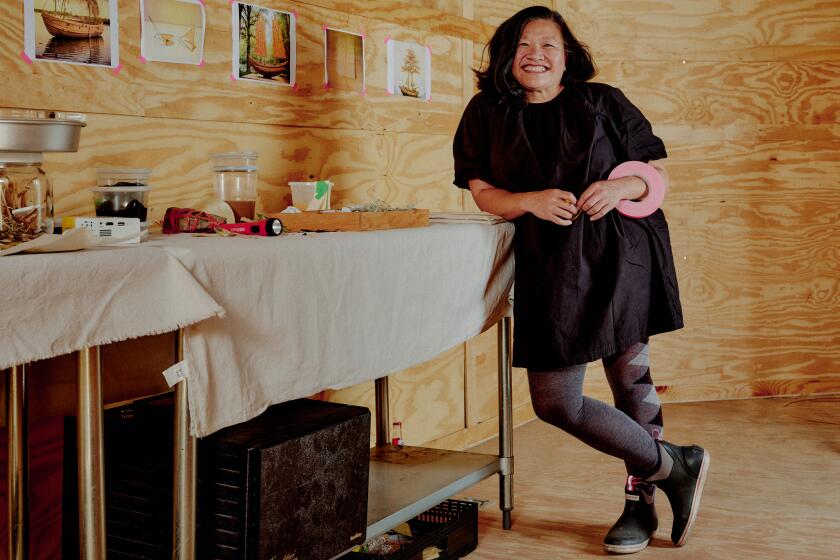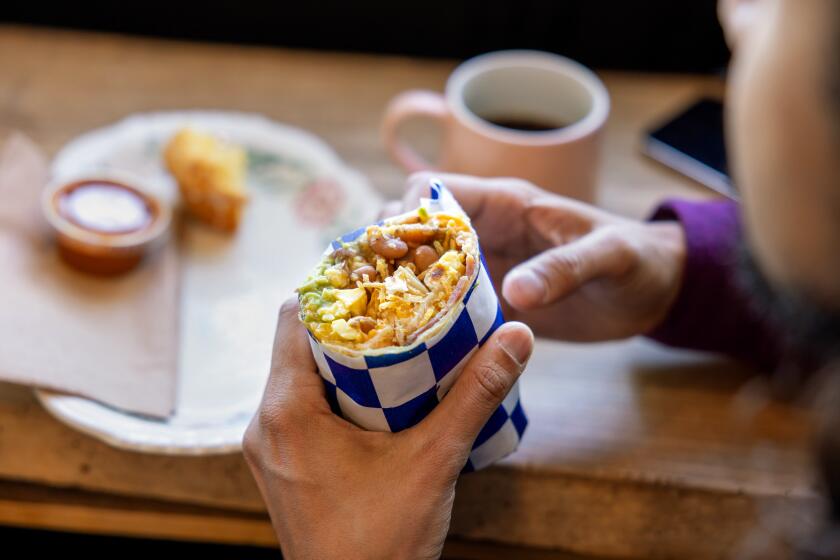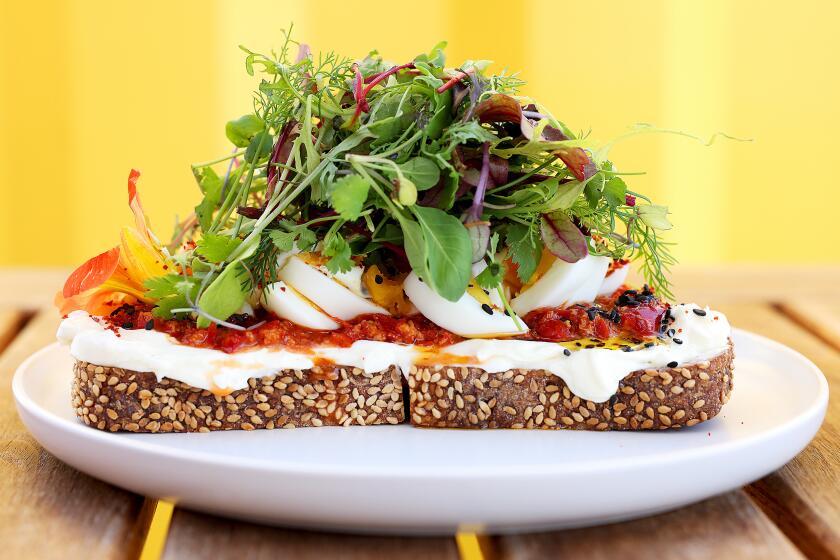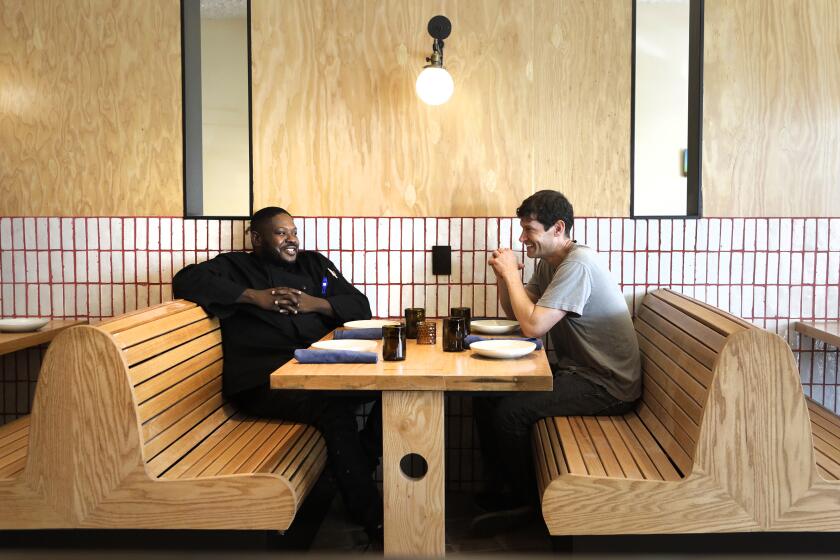Our L.A. food critic’s highly specific guide to San Francisco dining
I’ve never subscribed to the “Los Angeles vs. San Francisco” competitive narratives, the ones that the ones that play off our obviously very different cities with broad, facile stereotypes. My brain fixates on dining cultures, and in some profound ways L.A. and S.F. fit together to fill in the Golden State puzzle. They big-picture complement each other.
A few recent weeks in the Bay Area reminded me of what a culinary marvel San Francisco continues to be.
Its latest generations of chefs, and diners, still produce winding lines for new spins on warming noodle bowls, season-driven pastries and bring-it-on takes of, say, retro Hong Kong-style black pepper steak sizzling on a fajita platter. (See: Four Kings.) Reservations for the most high-flying tasting menus are certainly easier to score post-pandemic, but despite the vagaries of the tech industry and tourism the region endures as the nation’s fine-dining capital. I know, I know, New York, New York: It has the talent but not the mind-blowing produce.

The restaurants in this guide lean into my personal tastes. I have a relationship with San Francisco that spans most of my adulthood, including a brief tenure as a food critic for the San Francisco Chronicle in the mid-2000s. (The current critics, MacKenzie Chung Fegan and L.A. native Cesar Hernandez, are worth the price of a subscription.) When anyone asks my parents about my career choice, they bring up a family vacation to the Bay Area in which they’d planned a week’s worth of activities, but my 16-year-old self mostly wanted to talk to the hotel’s concierge about which great restaurants we should try.
It had been since before 2020 that I had spent real time in San Francisco, and in the wake of the city’s persistent doom-loop storylines I wanted to experience things for myself.
Some aspects were jarring. True to her word, San Francisco Mayor London Breed launched an assertive sweep of homeless encampments through the city. At the end of August, I walked Market Street one evening from the Ferry Building to the Castro and the thoroughfare was empty. Eerily, apocalyptically empty.
Some aspects were as timeless as ever. Walking to early dinners some nights, the fog rolled in fast and low, cutting off the blue sky like a stealth alien force encircling the city.
In acknowledging its many facets, San Francisco remains an exceptional dining town. Rather than chasing all the latest openings, I sought to convey a holistic taste of the abundance, from taquerias to once-in-a-lifetime extravagances. They’re ordered according to my own ambling intuition.
One note: Other corners of the Bay Area, especially Oakland and wine country, deserve their own focused considerations. I’m spending time on the road this year, dining through much of the state, and I’ll have more thoughts on Northern California in the coming months.


New Cantonese royalty: Four Kings

Cambodian noodles arrive at the Ferry Building: Lunette

Dim sum excellence: Hong Kong Lounge Bistro
Four years after Annie Ho’s beloved Hong Kong Lounge II burned down in the Richmond, she resurrected the business in a small SoMa space with translucent windows, carpeting and soothing pinkish walls. It looks and feels like a waiting room for the afterlife. The dim sum is some of the best I’ve had in California. Go for it: textbook shiu mai and har gau, slippery noodle rolls, a nicely unctuous steamed turnip cake in XO sauce, sticky rice in lotus leaf with delicate bits of sausage and other meats. The custard in the dan tat (egg tarts) tasted a little diluted, but that was the only complaint I heard loudly among my table full of hardline Cantonese eaters, some of whom had been put off by the word “bistro” in the new name and had skirted the place. Now they’re converts.

Italian for a special occasion: Quince

Italian for a dream lunch: Cotogna

A Fillmore District daughter comes home: Minnie Bell's Soul Movement

A stunning taste of Kerala: Copra

An evolution of Cantonese cooking: Mister Jiu's
Jew’s aim for the restaurant has always been to reinterpret the Cantonese cuisine of his youth. He’s experimented with form over the years, currently landing on a tasting menu that, during my late-summer dinner, included courses like eel clay pot rice lightened with summer squash and an outstanding guinea hen roulade in chicken broth so vivid in its poultry essence that the mind goes still between spoonfuls. An urging: Pre-order a supplemental course of Peking-style roast duck. It’s generous in size, the bird’s skin gleamingly lacquered, and comes with genius sides of peanut butter hoisin and whipped duck liver mousse.

The Eastern Mediterranean meets California: Dalida

Palestinian comfort food: Beit Rima

Transcendent ramen: Noodle in a Haystack

Modern Korean cuisine from a chef’s chef: Benu
In the mid-2020s New York’s fanciest “Korean wave” restaurants help set the tone for the city’s high-end dining scene, and Los Angeles has upstarts like Baroo and Yangban. Lee no longer stands alone, but his cooking has matured: less blatant modernism, more emphasis on Korean dishes. Small presentations like a two-bite toast of Pacific anchovy with house-fermented tomato ssamjang lead to a finale of ginseng-poached quail, its skin rendered to amber, served with flawless rice fragrant with green onion and sides that include salted shrimp salsa. I hear rumblings sometimes that Lee’s technically rigorous food comes off too subtle on the palate. In my handful of dinners at Benu over the last decade, I’ve never come away from his singular show of intellect and identity feeling anything less than inspired.

Cutting-edge Korean barbecue: San Ho Won
Could Los Angeles, such a bastion of traditional and casual Korean cooking, be ready for a similarly outside-the-box vision of KBBQ? It would take the right talent, right location, right timing. Lee and Hwang have given California one blueprint for possibilities.

Amazing, but don’t call it “Hawaiian:” Liholiho Yacht Club

An artist in residence: Atelier Crenn
Dominique Crenn is a force — of nature, of artistry, of personality — and she’s kept her Cow Hollow mothership in a flow of creative self-discovery since opening in 2011. From a basic description you probably know if you’re in or out with Crenn: The menu, written as a poem, orbits around seafood and vegetables, and dinner unfolds as a series of small courses. The price is $395 per person. From a critical vantage, what I’ve always admired about Crenn is the happy medium she achieves between modernism (a gushing cocoa butter shell filled with a play on a Kir Breton cocktail kicks off dinner) and low-to-the-ground locavorism (the restaurant maintains a farm), between cerebral leaps and undisguised pleasure. Her secret weapon has long been her business partner and pastry chef Juan Contreras. He matched her crab tart, for example, with a finale tostada made from rice, potato and masa, which he brushed with a coconut-based laminate to protect the crunch from layers of pistachio cream and raspberries that tasted of roses. This is also the rare restaurant in which the nonalcoholic pairing of teas and other potions are as interesting as the wines.

A great definition of “Modern Californian:” The Progress

A still-vital Moroccan institution: Aziza

An amazing primer on Guamanian cooking: Prubechu

Thai finer dining: Kin Khao

An essential Bay Area izakaya: Rintaro

Super-spicy Northern-style Chinese: Old Mandarin Islamic Restaurant

Timeless elegance: Acquerello

Ideal picnic hoagies: Palm City

Savory pastry marvels: Maison Nico

Your Arab corner bakery: Reem's Mission

Yes, stand in line for these pastries: Breadbelly

Croissant heaven: Arsicault Bakery

A cocktail gamechanger: True Laurel
Turkish, plus amazing wine: Kitchen Istanbul

For pourover geeks: Coffee Movement

For serious tea drinkers: Song Tea & Ceramics

One burrito to rule them all: La Taqueria

A restaurant that matters to me forever: Zuni Café
Eating here, particularly during lunch on an overcast afternoon, can almost feel haunted, as if the emotions felt by patrons through the decades seeped into the walls and want to slowly bleed back out. Sipping vermouth feels right and civilized in its rooms.
Judy Rodgers codified the restaurant’s style through the 1990s, marrying impeccable produce and pedigreed meats with gentle borrowings primarily from the Italian and French repertoires. Rodgers died of cancer in 2013; Anne Alvero, the latest chef to run the kitchen, took over in 2022. In MacKenzie Chung Fegan’s recent assessment of Zuni for the Chronicle, she pronounced the legendary roast chicken “good,” and impossible to live up to its reputation, and I agree. I’m still deeply charmed by the bowl of polenta (I ask for both mascarpone and Parmesan, rather than choosing one, and the kind, aproned servers indulge me), and revolving entrees like roasted duck leg with dates and pancetta, and the silly, joyful pyramid of shoestring potatoes.
We need physical places, more than ever, that can be backgrounds and vessels for meaning in our lives. I have really loved four men in my life, and Zuni Café is the only restaurant in my food-focused existence where I have shared a meal with each of them over two decades. The most recent was last year. You can guess, then, where I stand on the topic of whether this icon continues to matter.
Eat your way across L.A.
Get our weekly Tasting Notes newsletter for reviews, news and more.
You may occasionally receive promotional content from the Los Angeles Times.









